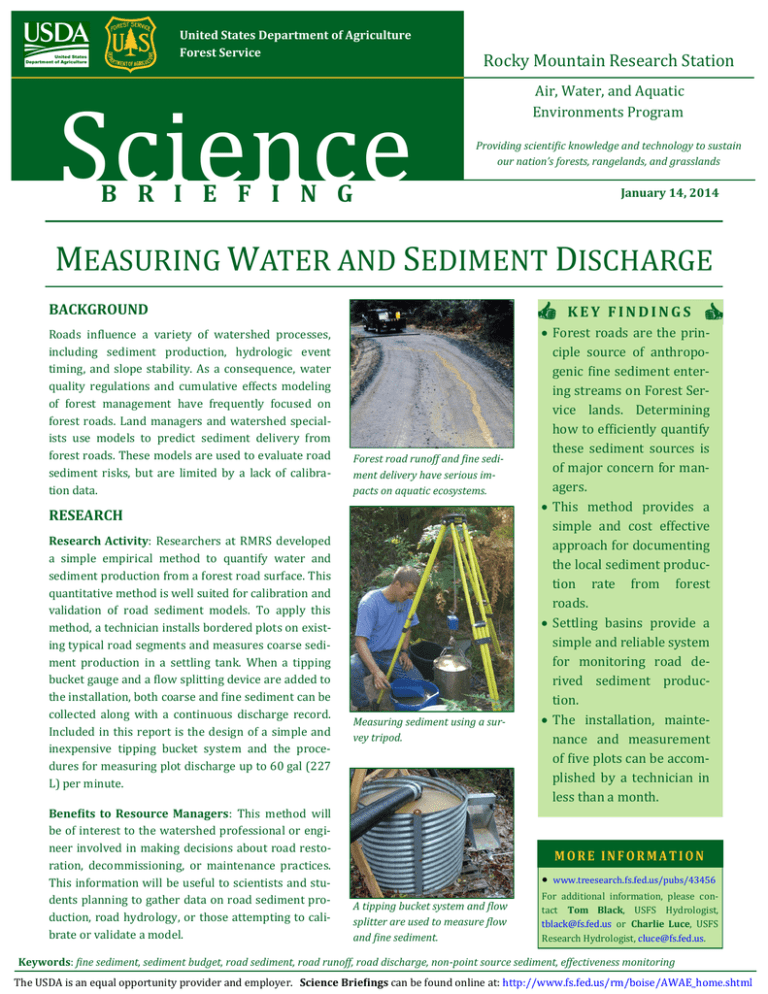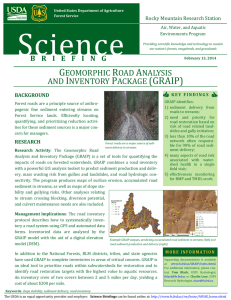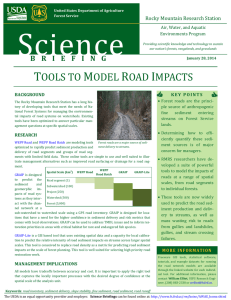Science
advertisement

United States Department of Agriculture Forest Service Science Rocky Mountain Research Station Air, Water, and Aquatic Environments Program Providing scientific knowledge and technology to sustain our nation’s forests, rangelands, and grasslands B R I E F I N G January 14, 2014 MEASURING WATER AND SEDIMENT DISCHARGE BACKGROUND Roads influence a variety of watershed processes, including sediment production, hydrologic event timing, and slope stability. As a consequence, water quality regulations and cumulative effects modeling of forest management have frequently focused on forest roads. Land managers and watershed specialists use models to predict sediment delivery from forest roads. These models are used to evaluate road sediment risks, but are limited by a lack of calibration data. KEY FINDINGS Forest road runoff and fine sediment delivery have serious impacts on aquatic ecosystems. RESEARCH Research Activity: Researchers at RMRS developed a simple empirical method to quantify water and sediment production from a forest road surface. This quantitative method is well suited for calibration and validation of road sediment models. To apply this method, a technician installs bordered plots on existing typical road segments and measures coarse sediment production in a settling tank. When a tipping bucket gauge and a flow splitting device are added to the installation, both coarse and fine sediment can be collected along with a continuous discharge record. Included in this report is the design of a simple and inexpensive tipping bucket system and the procedures for measuring plot discharge up to 60 gal (227 L) per minute. Benefits to Resource Managers: This method will be of interest to the watershed professional or engineer involved in making decisions about road restoration, decommissioning, or maintenance practices. This information will be useful to scientists and students planning to gather data on road sediment production, road hydrology, or those attempting to calibrate or validate a model. Measuring sediment using a survey tripod. Forest roads are the principle source of anthropogenic fine sediment entering streams on Forest Service lands. Determining how to efficiently quantify these sediment sources is of major concern for managers. This method provides a simple and cost effective approach for documenting the local sediment production rate from forest roads. Settling basins provide a simple and reliable system for monitoring road derived sediment production. The installation, maintenance and measurement of five plots can be accomplished by a technician in less than a month. MORE INFORMATION A tipping bucket system and flow splitter are used to measure flow and fine sediment. www.treesearch.fs.fed.us/pubs/43456 For additional information, please contact Tom Black, USFS Hydrologist, tblack@fs.fed.us or Charlie Luce, USFS Research Hydrologist, cluce@fs.fed.us. Keywords: fine sediment, sediment budget, road sediment, road runoff, road discharge, non-point source sediment, effectiveness monitoring The USDA is an equal opportunity provider and employer. Science Briefings can be found online at: http://www.fs.fed.us/rm/boise/AWAE_home.shtml







